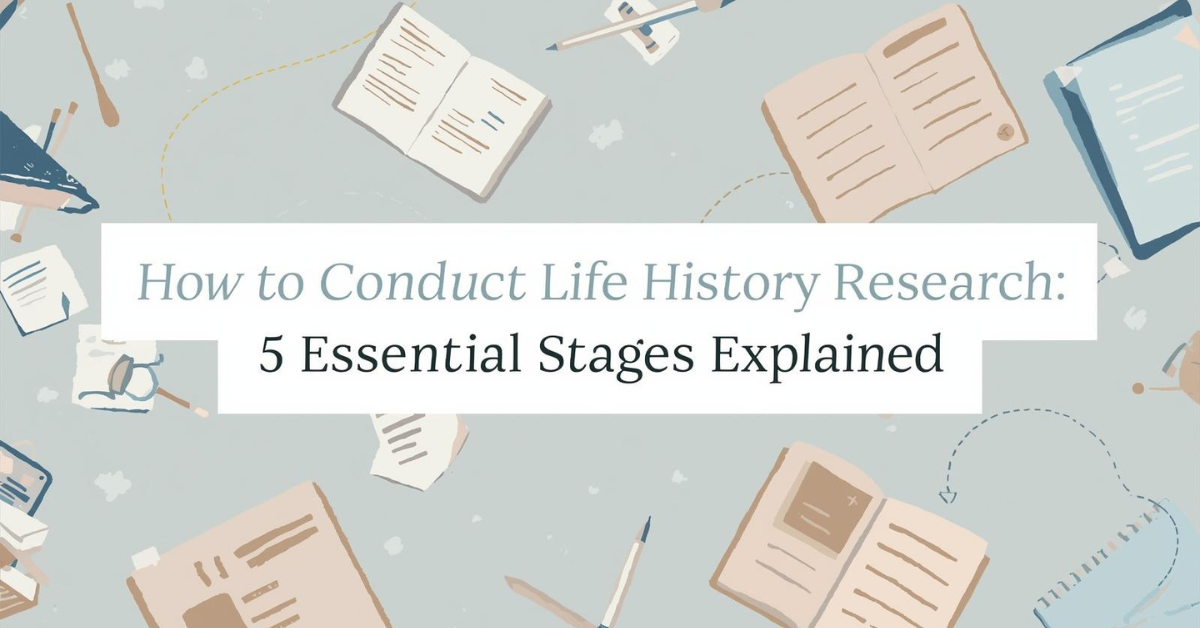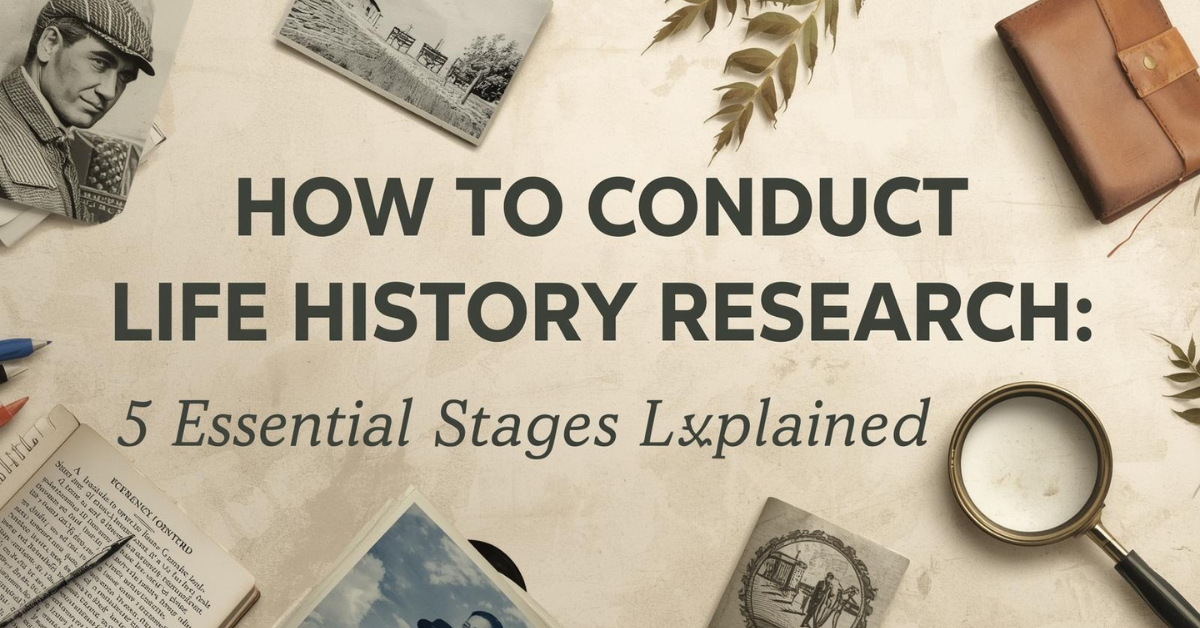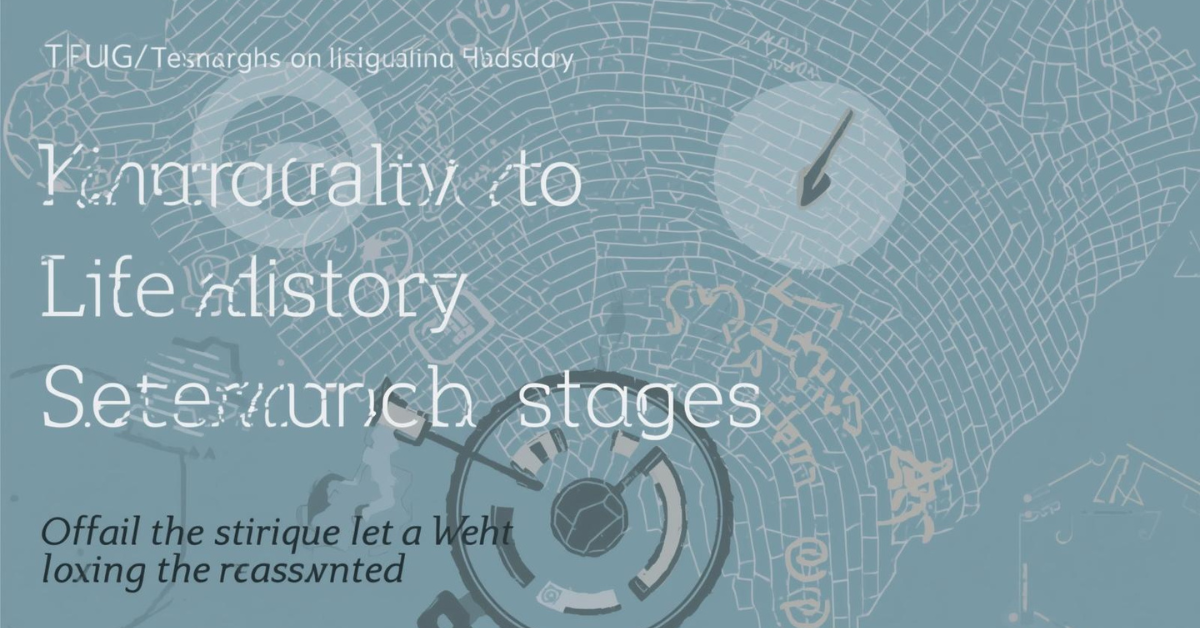How to Conduct Life History Research: 5 Essential Stages Explained are the Conceptual Phase, Design and Planning Phase, Empirical Phase, Analytic Phase, and Dissemination Phase.
How to Conduct Life History Research: 5 Essential Stages Explained
To conduct life history research, you typically follow five essential stages: 1. Identify the Topic and Research Question, 2. Design the Research Methodology, 3. Gather Primary and Secondary Data, 4. Analyze and Interpret the Data, and 5. Synthesize and Report Findings. This process involves building trust with participants, collecting data through interviews and documents, identifying themes and patterns, and then constructing a coherent narrative from the data.
Life History Research Methodology: A Comprehensive Guide
This involves the researcher both in selecting an appropriate problem and devising relevant research techniques.
Stage 1 – Preparation: Laying the Foundation for Life History Research
Selecting Your Research Subject
Questions to be asked at this stage are first. Who is to be the object of the study?’—the great person, the common person, the volunteer, the selected, the coerced?
Identifying What Makes a Good Informant
Second What makes a good informant?’ Plummer draws attention to key factors such as accessibility of place and availability of time, and the awareness of the potential informant of his/her particular cultural milieu. A good informant is able and willing to establish and maintain a close, intimate relationship with the researcher. It is axiomatic that common sympathies and mutual respect are prerequisites for the sustenance and success of a life history project.
Key Questions to Clarify Early in Your Research
Third, ‘What needs clarifying in the early stages of the research?’ The motivations of the researcher need to be made explicit to the intended subject. So too, the question of remuneration for the subject’s services should be clarified from the outset. The issue of anonymity must also be addressed, for unlike other research methodologies, life histories reveal intimate details (names, places, events) and provide scant cover from prying eyes. The earlier stages of the project also provide opportunities for discussing with the research subject the precise nature of the life history study, the logistics of interview situations and modes of data recording.
Stage 2 – Data Collection: Mastering Interview Techniques
Types of Interview Approaches
Central to the success of a life history is the re searcher’s ability to use a variety of interview techniques . As the occasion demands, these may range from relatively structured interviews that serve as general guides from the outset of the study, to informal, unstructured interviews reminiscent of non-directive counseling approaches espoused by Carl Rogers (1945) and his followers. In the case of the latter, Plummer (1983) draws attention to the importance of empathy and ‘non-possessive warmth’ on the part of the interviewer-re searcher.
Blending Participant Observation with Casual Conversation
A third interviewing strategy involves a judicious mixture of participant observation and casual chatting, supplemented by note-taking.
Stage 3 – Data Storage: Managing Your Research Materials
Typically, life histories generate enormous amounts of data.
Recording and Transcription Strategies
Intending researchers must make early decisions about the use of tape-recordings, the how, what and when of their transcription and editing.
Coding and Filing Systems
And the development of coding and filing devices if they are to avoid being totally swamped by the materials created. Readers are referred to the discussion and to Fiedler’s (1978) extensive account of methods appropriate to field studies in natural settings.
Stage 4 – Data Analysis: Ensuring Quality and Credibility
Addressing Representativeness in Life History Research
Three central issues underpin the quality of data generated by life history methodology. They are to do with representativeness; reliability and validity. Plummer draws attention to a frequent criticism of life history research, namely that its cases are atypical rather than representative. To avoid this charge, he urges intending researchers to ‘work out and explicitly state the life history’s relationship to a wider population’ (Plummer, 1983) by way of appraising the subject on a continuum of representativeness and non-representativeness.
Identifying and Reducing Bias for Reliable Results
Reliability in life history research hinges upon the identification of sources of bias and the ap plication of techniques to reduce them.
Validity Checks: Four Methods to Verify Your Findings
Bias arises from the informant, the researcher, and the interactional encounter itself (Plummer, 1983), and these were presented. Several validity checks are available to intending researchers. Plummer identifies the following:
- The subject of the life history may present an autocritique of it, having read the entire product.
- A comparison may be made with similar writ ten sources by way of identifying points of major divergence or similarity.
- A comparison may be made with official records by way of imposing accuracy checks on the life history.
- A comparison may be made by interviewing other informants. Essentially, the validity of any life history lies in its ability to represent the informant’s subjective reality, that is to say, his or her definition of the situation.
Stage 5 – Data Presentation: Writing and Publishing Your Life History
Plummer provides three points of direction for the researcher intent upon writing a life history. First, have a clear view of who you are writing for and what you wish to accomplish by writing the account.
Case History vs. Case Study: Defining Your Purpose
Are you aiming to produce a case history or a case study? Case histories ‘tell a good story for its own sake’ (Plummer, 1983). Case studies, by contrast, use personal documents for wider theoretical purposes such as the verification and/or the generation of theory. Second, having established the purpose of the life history, decide how far you should intrude upon your assembled data.
The Art of Editing Without Losing Authenticity
Intrusion occurs both through editing and interpreting. Editing (‘cutting’, sequencing, disguising names, places etc.) is almost a sine qua non of any life history study. Paraphrasing Plummet, editing involves getting your subject’s own words, grasping them from the inside and turning them into a structured and coherent statement that uses the subject’s words in places and your own, as researcher, in others, but retains their authentic meaning at all times.
Best Practices for Writing Your Life History Report
Third, as far as the mechanics of writing a life history are concerned, practise writing regularly. Writing, Plummer observes, needs working at, and daily drafting, revising and redrafting is necessary. For an example of life history methodology and research see Evetts (1991).
Conclusion
Conducting life history research is both a scientific and humanistic journey. It allows researchers to uncover the personal narratives that shape individuals’ experiences, values, and identities. By following the five essential stages — from selecting participants and collecting data to analyzing and interpreting narratives — you can ensure that each story is documented with authenticity and ethical responsibility.
Life history research not only deepens our understanding of people’s lives but also enriches nursing, education, and social sciences by giving voice to those whose experiences often remain unheard. Ultimately, it bridges data with humanity — transforming stories into knowledge that inspires learning, compassion, and social change.
Frequently Asked Questions (FAQs)
1. What is the main purpose of life history research?
Life history research aims to explore an individual’s lived experiences through their personal narrative. It helps researchers understand how social, cultural, and environmental factors shape human behavior and identity over time.
2. How is life history research different from a case study?
While both approaches focus on individuals, a case study investigates a specific situation or phenomenon, whereas life history research emphasizes the entire life trajectory of the person — capturing key events, emotions, and meanings.
3. What types of data are collected in life history research?
Data typically include interviews, diaries, letters, photographs, oral histories, and personal artifacts. These help the researcher reconstruct the individual’s experiences across different life stages.
4. How do researchers ensure accuracy in life history data?
Accuracy is maintained by triangulating data from multiple sources, verifying facts with participants, maintaining reflexive notes, and interpreting stories within their social and cultural context.
5. Why is life history research valuable in nursing and healthcare?
In nursing, understanding patients’ life histories enhances person-centered care, empathy, and cultural competence. It helps practitioners see beyond the illness — focusing on the individual’s story, values, and coping mechanisms.
6. What are the ethical considerations in life history research?
Researchers must obtain informed consent, ensure confidentiality, avoid misrepresentation, and respect the participant’s emotional well-being throughout the process of storytelling and publication.
7. Can life history research be used in quantitative studies?
While primarily qualitative, life history data can complement mixed-method research — providing deep insights that explain or support quantitative trends and statistical findings.
Read More:
https://nurseseducator.com/didactic-and-dialectic-teaching-rationale-for-team-based-learning/
https://nurseseducator.com/high-fidelity-simulation-use-in-nursing-education/
First NCLEX Exam Center In Pakistan From Lahore (Mall of Lahore) to the Global Nursing
Categories of Journals: W, X, Y and Z Category Journal In Nursing Education
AI in Healthcare Content Creation: A Double-Edged Sword and Scary
Social Links:
https://www.facebook.com/nurseseducator/
https://www.instagram.com/nurseseducator/
https://www.pinterest.com/NursesEducator/
https://www.linkedin.com/company/nurseseducator/
https://www.linkedin.com/in/nurseseducator/
https://www.researchgate.net/profile/Afza-Lal-Din
https://scholar.google.com/citations?hl=en&user=F0XY9vQAAAAJ


**mindvault**
Mind Vault is a premium cognitive support formula created for adults 45+. It’s thoughtfully designed to help maintain clear thinking
**mindvault**
mindvault is a premium cognitive support formula created for adults 45+. It’s thoughtfully designed to help maintain clear thinking
abc123123123123